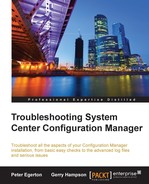Hopefully, this chapter helped you to understand the different levels of logging and status checking available to us in Configuration Manager. They scale from high-level charts in the console monitoring workspace for the uninitiated or first timer through to the deep low-level logs that can take some time to trawl through. As a general rule, it is recommended to always work through those quick and easy checks and then drill down into the relevant log file afterward. Once we become familiar with the log files, we can then jump straight in and use the various tools listed in Chapter 1, The Configuration Manager Troubleshooting Toolkit, to figure out what is going on. It would be impossible to list every available error message in this book, so it is advised that we use the standard lists from Chapter 1, The Configuration Manager Troubleshooting Toolkit, and hit the Web. Try not to get side-tracked by other interpretations and keep the approach logical. It may surely take some time, but there is no black magic, and everything has a solution, otherwise you may have found a bug in the product that can be reported on Microsoft Connect, which is a great resource to check if you think you may have done so. The Configuration Manager product group at Microsoft do read these reports and do fix them, so go ahead and log something. In the next chapter, we will look specifically at troubleshooting Configuration Manager clients. This includes which log files to use, how we can extend them, and what options we have available.
